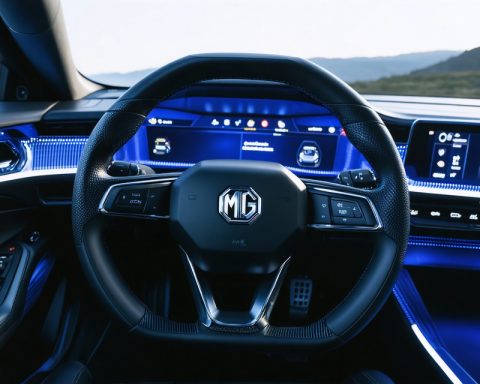- Norway leads the global electric vehicle (EV) market, with nearly 80% of new car sales being electric, driven by progressive environmental policies.
- Generous tax incentives, toll exemptions, and bus lane access make EVs attractive to consumers, backed by strong governmental support.
- Norway’s vast hydroelectric power resources provide renewable energy for EVs, supporting a green energy ecosystem.
- The nation’s commitment to sustainability is reflected in its culture and infrastructure, aiming for a zero-emission future.
- Norway’s small size is overshadowed by its large-scale environmental impact, offering a model of innovation and action for the world.
Norway, a nation renowned for its stunning fjords and rich Viking history, stands at the forefront of the electric vehicle (EV) revolution. While the world grapples with carbon emissions and seeks cleaner modes of transportation, Norway has tirelessly charged ahead, setting a shining example for the rest of the globe.
Nestled in the heart of Scandinavia, Norway boasts an astonishing statistic: nearly 80% of all new cars sold are electric. This staggering figure roots itself deeply in the government’s ambitious environmental policies, paved with generous tax incentives and strategic infrastructure investments.
Picture this: sleek Teslas, compact Nissan Leafs, and other cutting-edge EVs glide effortlessly across the Norwegian landscape. Charging stations dot every highway and city avenue, lighting up the winter darkness like beacons of progress. The vision of a zero-emission future doesn’t just linger on the horizon here—it’s being actively crafted every day.
But why Norway? What makes this nation uniquely poised to dominate the EV market? The answers lie in a combination of governmental foresight, social consciousness, and a population enthusiastic about sustainability. The Norwegian government, recognizing the catastrophic effects of climate change, has implemented bold incentives. EV buyers enjoy significant tax breaks, exemption from toll charges, and access to bustling bus lanes, making electric an irresistible choice.
Moreover, Norway’s commitment to hydroelectric power provides a renewable backbone to its EV ecosystem, ensuring that electric cars run on green energy from start to finish. A land of waterfalls and rivers, Norway harnesses these natural resources to generate almost all of its electricity from hydroelectric plants. This synergy between electric cars and clean electricity presents a model of environmental responsibility.
This narrative extends past numbers and policies; it breathes life into an ideal shared by millions. Imagine standing on the snow-dusted streets of Oslo, where the silent hum of EVs replaces the usual traffic roar. It becomes clear that Norway’s strategy isn’t just about technology—it embodies a culture dedicated to a sustainable future.
Other nations may possess larger economies or bigger populations, yet Norway’s small size betrays a big heart for innovation. Here, pioneering spirit meets environmental stewardship, demonstrating that substantial change requires more than words—it demands action.
The rest of the world watches as Norway leads this green transformation, proving that when legislation, culture, and technology unite, a cleaner future isn’t just possible; it’s palpable. The world can learn from Norway’s electric journey: when charging ahead, choose the path of sustainability, and the rest will follow.
Norway’s story teaches us a crucial lesson: a sustainable future isn’t a distant dream; it’s a doable reality when we collectively strive toward it.
The Secret Behind Norway’s Thriving Electric Vehicle Market
The Rise of Electric Vehicles in Norway: Key Insights
Norway’s commitment to electric vehicles (EVs) showcases a uniquely successful blend of government policy, environmental stewardship, and citizen enthusiasm. As the world seeks effective strategies to combat carbon emissions and promote sustainability, Norway’s model offers valuable insights.
How Norway Became the EV Capital of the World
1. Generous Government Incentives: Norway’s government has implemented substantial incentives to encourage EV adoption. These include exemptions from registration taxes and VAT on electric cars, creating a significant cost advantage over traditional vehicles. Additionally, EV owners enjoy reduced road tolls, free municipal parking, and the privilege of using bus lanes.
2. Comprehensive Charging Infrastructure: The country has invested heavily in a widespread charging network. This includes fast chargers that provide quick refueling options, ensuring that drivers can travel without range anxiety. As of 2023, Norway boasts an extensive network of over 17,000 public charging points, facilitating seamless long-distance travel across the nation.
3. Renewable Energy Backbone: Nearly all of Norway’s electricity comes from hydropower. This means that charging an electric vehicle in Norway has a smaller carbon footprint, reinforcing the environmental benefits of EVs. This synergy between renewable energy and electric vehicles sets Norway apart as a global leader in sustainable transportation.
4. Cultural Commitment to Sustainability: Norwegians are known for their environmental consciousness, which aligns well with national policies. This societal ethos makes green choices popular and socially rewarding, further driving the adoption of electric vehicles.
Real-World Use Cases and Lessons for Other Nations
– Replication Potential: Countries looking to emulate Norway’s success should consider a tailored approach, taking into account their unique geography, economy, and available resources. Adopting Norway’s policy framework requires an integrated strategy that includes infrastructure investment and public engagement.
– Community Involvement: Encouraging public buy-in through educational campaigns can mirror Norway’s success. Community programs that highlight the environmental and economic benefits of EVs can shift public perception and accelerate adoption.
Market Forecasts and Industry Trends
– Continued Growth: According to industry analysts, Norway’s EV market is expected to maintain strong growth in the coming years, largely driven by continued policy support and advances in battery technology.
– Battery Innovations: As battery costs decrease and efficiency improves, EVs will become even more attractive. This trend could lead to further skyrocketing sales, not only in Norway but across the globe.
Challenges and Limitations
– Heavy Reliance on Government Incentives: The sustainability of robust government incentives must be evaluated continuously to ensure market stability.
– Cold Weather Impact: Norway’s harsh winters affect battery performance. Ongoing research into improving battery durability and efficiency in cold climates is crucial.
Pros and Cons Overview
Pros:
– Strong government support and incentives make EVs financially appealing.
– Extensive charging network alleviates range anxiety.
– Renewable energy sources provide eco-friendly charging.
Cons:
– High initial investment in charging infrastructure.
– Market dependency on continued government incentives.
Actionable Recommendations
1. Governments Globally: Policy makers should prioritize creating comprehensive incentive structures and invest in charging infrastructure.
2. Consumers: Consider the total cost of ownership savings from EV incentives and low maintenance compared to combustion vehicles.
3. City Planners: Develop urban plans that incorporate EVs into public transportation, reducing traffic congestion and pollution.
Norway’s journey is a testament to the power of policy, technology, and cultural cohesion in driving meaningful environmental change. For those looking to spearhead similar transformations, Norway provides a compelling blueprint worth emulating.
For more in-depth information about sustainability and electric vehicles, visit the official site: Norwegian Government.















